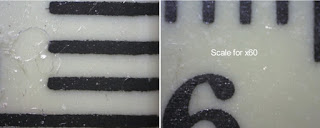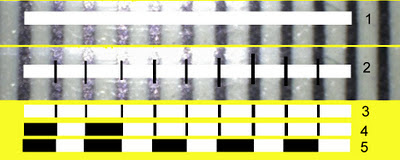(Using oil immersion isn't amateur stuff: it requires really thin sections or flat squash preparations, and you have to join the cover skip and the objective with a drop of oil. It's like walking a tight-rope! {The first time I heard women routinely swearing was in a final-year undergrad genetics class, and the cause was the same: cracking the cover-slip by driving the objective through it. The males, let me say, were just as bad, but back then, women swearing was still a bit of a novelty.})
Anyhow, back in the 1960s, and back into the 19th century, you had to draw what you saw with pencil on paper, which was hard on lousy artists. Even though you probably magnified or reduced what you saw through the eyepiece, you still slavishly reproduced the "magnification" as if it had some magical power.
These days, we tend to use a computer and store the images online, but while the microscope claims a certain magnification, it all depends on what size monitor you are using, along with any resizing that occurs afterwards. I have shown my rather large monitor before, but viewing the same image on the tablet of the netbook would be very different.
The only proper way to report sizes is to have a standard measure, a calibrated scale that you can superimpose on any image. This blog entry is about creating a set of those to match the claimed "magnifications" of your microscope. The careful reader may remember that my little cheap glorified webcam claims to deliver x10, x60 and x200. As I have said before, and as you will see if you scrutinise the shots here, these figures are a bit rubbery, but first, let's look at focal plane effects.
Here are three shots of a paper-clip, taken at those three magnifications. As you can see, the camera has trouble keeping the whole of the paper-clip in focus at the higher magnifications. The pixels may still be tiny, but the whole picture is blurry. That's why we need thin sections, which is why you need a microtome.
I'm going to avoid further technicalities, but if you want to get really serious, you need to know about resolution, the wave-length of light and other stuff we aren't going to get into right now. I'm sure some brave soul has explained it all well!
I just want a scale in terms of size, something that can travel with the image and always tell the truth.
 So I put an ordinary millimetre ruler (that's a "rule" in some places).
So I put an ordinary millimetre ruler (that's a "rule" in some places).Then I took shots of it at each of the three magnifications.
Remember that each of these resized pics was originally 1280 x 1024.
That means the scale you see there tells you the size of the field I was looking at.
(This, by the way, is the point where the clever reader will go "Hmmm!" and start doing sums which will reveal how rubbery those claimed magnifications were.)

I wanted to have a reference marker I could paste onto any picture that I took at each "magnification" that would give an accurate scale.
I'm old fashioned, and I used Corel Photopaint to create a white bar, 10 mm long (1), Then I put black cross-bars in at each millimetre (2). Next, I cropped out the white box (3) and used flood-fill to blacken every second white box (4) and (5).
And here is the final product. The labels, x10. x60 and x200 have been added, as has the coloured background, so you can see how small these items are. Notice that I have blown them up here: it is important that the original scale bar goes on every original image, before it is resized or pasted into a blog which may do odd thins when it encounters strange displays.
Once you have your bars, all you have to do is choose the appropriate one, open it and a picture at the same "magnification" and paste it onto that picture. Most graphics programs will let you drag the pasted image around. Then label the bar for length, save the composite, and you can resize to your heart's content.
In the example above, I have a very small sea-urchin test, sitting on a ruler, graduated in millimetres. That's another solution, but it isn't always possible.
This is boring. I'm not doing any more. Here's another puzzle for you.
What's this thing? When I give you the answer, you will see why scale is important!
Oops! I never did give a link to the answer. Here it is!






No comments:
Post a Comment